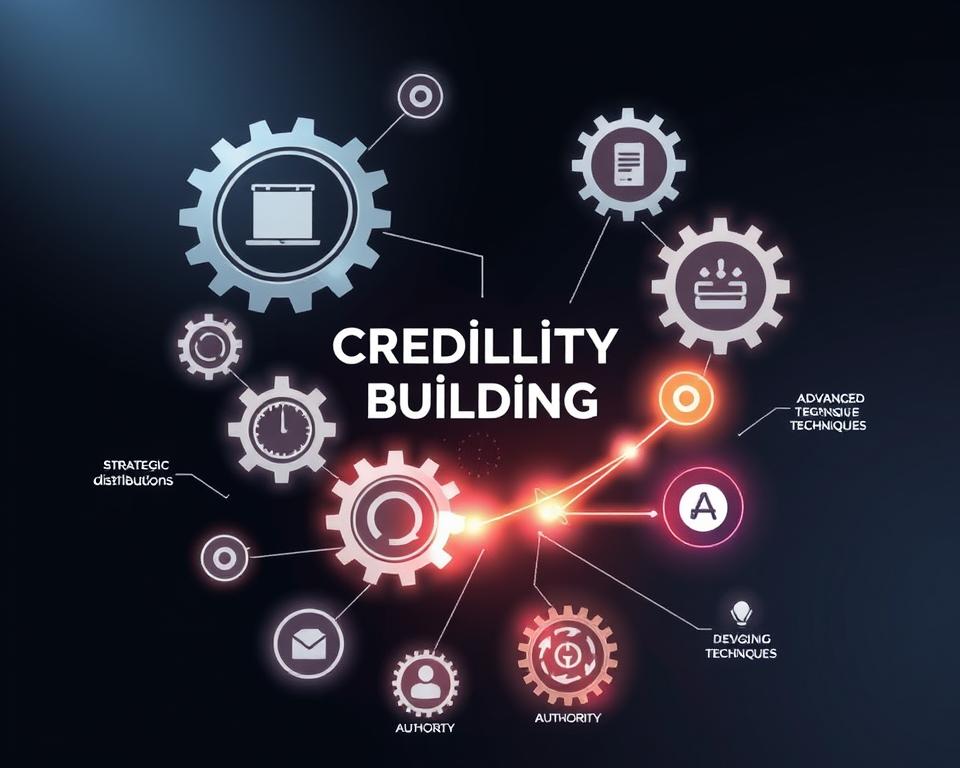Did you know 90% of consumers trust recommendations from others? This makes building brand credibility through content very important. It’s key for businesses to stand out in today’s digital world. By making content that our audience loves, we show we’re trustworthy. This helps our business grow and succeed.
We’ll look at how to make content that our audience will love. This content should make our brand look credible and trustworthy. It’s all about creating content that’s both useful and fun to read.
Key Takeaways.
- Building brand credibility through content is essential for businesses in today’s digital landscape.
- Establishing brand authority with content helps to position our brand as a trustworthy authority in the industry..
- Strategic content creation is critical for driving business growth and success.
- Informative and engaging content is key to resonating with our target audience.
- Building brand credibility and authority through content takes time and effort, but is essential for long-term success.
- Our content strategy should focus on creating content that is both credible and trustworthy.
Understanding the Fundamentals of Building Brand Credibility Through Content.
Exploring brand credibility, we see content’s key role in building trust with our audience. Brand credibility strategies are vital for this. By making high-quality, relevant, and consistent content, we show our expertise and value.
For content credibility for brands, focus on consistency, quality, and relevance. This approach helps us create content that our audience loves. It also builds trust in our brand.
- Creating informative and engaging content that addresses the needs of our audience.
- Utilizing various content formats, such as blog posts, videos, and social media posts, to reach our audience.
- Collaborating with industry experts and thought leaders to add credibility to our brand.
By using these strategies, we can make our brand a trusted name in our field. We build strong, lasting relationships with our audience.
| Content Strategy | Benefits |
|---|---|
| Consistent Content | Establishes trust and credibility with audience |
| High-Quality Content | Demonstrates expertise and showcases brand value |
| Relevant Content | Resonates with target audience and builds brand loyalty |
Crafting Your Content Strategy for Maximum Impact.

To make a successful content marketing plan, we must know our audience well. We also need a content calendar that keeps things fresh and consistent. Good storytelling is key to connecting with our audience on an emotional level. This makes our brand more relatable and easy to remember.
When planning our content, we should keep a few things in mind:
- Know what our audience likes and needs.
- Plan a content calendar that keeps things interesting.
- Find the best ways to share our content.
- Use storytelling to connect with our audience.
By focusing on these areas, we can make our content marketing work for our brand’s credibility. Content marketing is a great way to build trust and authority. It makes our brand more relatable and memorable.
By following these steps and adding the right elements to our strategy, we can achieve great results. A well-thought-out content plan and effective storytelling can help us win our audience’s trust. This establishes our brand as a leader in our field.
Essential Content Types That Build Trust and Authority.
Creating certain types of content can really help build trust and boost our brand’s reputation. By making and using these content types, we can show we’re leaders in our field. We can share our knowledge and vision with others.
Content like thought leadership articles, case studies, educational resources, and expert interviews are key. They show we care about teaching and helping our audience. They also prove our brand’s worth and the value we bring.
Thought Leadership Articles and Industry Insights.
Thought leadership articles and insights make our brand a trusted voice in the industry. They highlight our expertise and vision. By sharing quality, informative content, we draw in and engage our audience. This builds trust and credibility with them.
Case Studies and Success Stories.
Case studies and success stories give real proof of what we can do. They show how our brand has helped others. This builds trust and credibility, proving our expertise and the results we can achieve.
Expert Interviews and Collaborations.
Expert interviews and collaborations boost our brand’s reputation by linking it with other industry leaders. By working with experts, we create top-notch content. This content showcases our expertise and our dedication to excellence.
Implementing Advanced Content Distribution Techniques.

To reach our target audience, we need to share our content on many channels. We use credibility building techniques to make a big impact. This means making our content fit for different platforms, so it connects with our audience and builds trust in our brand.
Using social proof like testimonials and reviews boosts our credibility. It shows we know what we’re talking about. Here are some ways to do it:
- Customer testimonials and case studies.
- Expert endorsements and reviews.
- User-generated content and social media engagement.
Also, teaming up with other content creators can grow our audience. Working with influencers, leaders, and brands lets us reach new people.
These advanced methods help us get seen more online, bring more visitors to our site, and increase our brand’s trustworthiness. By using credibility building techniques and social proof in our strategy, we become a go-to source in our field.
Conclusion: Sustaining Long-Term Brand Authority Through Consistent Content Excellence.
As we wrap up this guide on building brand credibility through content, it’s key to stress the importance of ongoing effort. Building brand authority is a continuous journey, not a single goal. By consistently making high-quality, informative, and engaging content, we solidify our trustworthiness in our field.
To keep our brand credibility strong, we need to be flexible and always ready to change our content strategy. We must listen to what our audience says and use data to guide us. This way, we stay relevant and valuable to our audience, making us leaders in our industry.
Content is the base for building lasting brand authority. With a smart, data-driven plan and a focus on delivering top-notch content, we can make our brand a symbol of expertise and reliability. Let’s take on this challenge with excitement and a commitment to go beyond our audience’s expectations, one piece of content at a time.





0 Comments